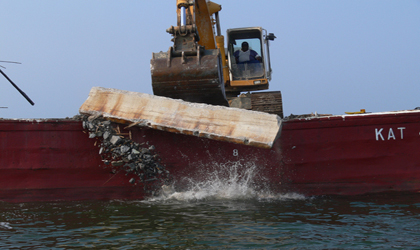U.S. Department of Transportation
Federal Highway Administration
1200 New Jersey Avenue, SE
Washington, DC 20590
202-366-4000
Focus
| Accelerating Infrastructure Innovations |
Publication Number: FHWA-HRT-09-012
Date: April 2009
Fish and other aquatic life in Maryland's Chesapeake Bay have vibrant new marine habitats to call home, thanks to concrete recycled from the former Woodrow Wilson Bridge that was used to create five major fish reefs in the bay and the Potomac River. "This is the most gratifying project I have ever worked on," says Michael Baker, Environmental Manager for the Woodrow Wilson Bridge Project. "Not only did we keep this material out of a landfill, but the reefs are doing phenomenally well and are already providing habitat for multiple fish species."
Built in 1961, the six-lane Woodrow Wilson Bridge outside of Washington, DC, was carrying nearly 200,000 vehicles daily by the late 1990s, almost three times its original intended traffic load. Construction on a new 12-lane bridge began in October 2000 and was completed in November 2008, although work has continued on four local interchanges that are part of the overall project. The Woodrow Wilson Bridge Project is jointly sponsored by the Federal Highway Administration (FHWA), Virginia Department of Transportation, Maryland State Highway Administration, and the District of Columbia Department of Transportation.
"We had been thinking about reef creation early on in the project, although it was not part of the contract or permit requirements," says Baker. At an estimated premium of $1.5 million over less expensive alternatives, however, the initiative appeared to be too costly for the contractors to consider. Agreements among the Maryland Department of Natural Resources (DNR) and two of the project contractors, American Bridge/Ed Kraemer & Sons and Potomac Constructors, moved the initiative forward, with the DNR contributing initial funding of $38,000 in a cost-sharing effort. Additional partners included the Coastal Conservation Association of Maryland (CCA MD), which created a "Buy a Ton of Reef" program; Mitchell-Petersen Foundation; Dominion Energy; Shell; and Honeywell, Inc.; as well as local charter boat captains and conservation and fishing organizations. With the help of the Maryland Legislative Sportsman's Foundation, working with the Maryland Legislative Sportsman's Caucus, the Maryland General Assembly passed a bond bill that contributed $500,000 to the effort. "It was a tremendous partnering effort," says Baker, who noted that the entire $1.5 million cost has been paid to the contractors, as committed. To support the effort and encourage future projects, the Maryland DNR and CCA MD established the Maryland Artificial Reef Initiative, a coalition of over 60 partners dedicated to improving and restoring marine habitats.
 |
| Steel drawbridge trunnions from the old Woodrow Wilson Bridge outside of Washington, DC, are placed at the Point No Point Reef near the mouth of the Potomac River. |
On August 4, 2006, the first load of concrete materials from the old bridge was taken by barge to the Point No Point reef in the Chesapeake Bay and placed on the bottom of the bay to bolster the reef. The resulting reef is now the size of two football fields. Over the next 2 years, 59,000 metric tons (65,000 tons) of materials were hauled out in 52 barge loads to create a total of five reefs in the Chesapeake Bay and the Potomac River. By comparison, from 1996 to 2006, 24,000 metric tons (27,000 tons) of materials had been used to create aquatic reefs in Maryland.
| The reefs are already supporting fish such as striped bass and bluefish, as well as benthic communities of mussels, barnacles, oysters, and tunicates. |
Prior to taking the barge loads, asphalt and materials such as oils, greases, and solvents were stripped off of the bridge and the structural steel was recycled. Materials such as concrete deck slabs and pier columns were the first items to be hauled. Project staff partnered with charter boat captains and the Maryland Geological Survey to choose the reef locations. After the old bridge was demolished with explosives, the resulting smaller concrete materials were hauled out to the bay and placed vertically on top of the deck slabs and other larger items in the reefs. The last load was placed on November 4, 2008.
"We thought it might take 3 to 5 years for the habitats to evolve. We first sent divers to the reefs in November 2007 and were amazed at how fast the ecosystems had developed," says Baker. The reefs are already supporting fish such as striped bass and bluefish, as well as benthic communities of mussels, barnacles, oysters, and tunicates.
"While this is not cost effective for every project and will have to be evaluated on a case-by-case basis for future projects, there is a lot of opportunity out there," says Baker. More recently, materials from a re-decking project on Maryland's Chesapeake Bay Bridge were used to create a reef in the Severn River, a tributary to the Chesapeake Bay. Additional reef projects are in the planning stage.
"When looking at recycling or reusing materials from a project, cost should not be the only deciding factor. The enhancement to the environment has a value that needs to be understood and factored into the decisionmaking. The establishment of living reefs will have a long-term positive impact on the bay," says Jason Harrington of FHWA.
For more information on the Woodrow Wilson Bridge reef initiative, contact Michael Baker at Potomac Crossing Consultants/URS, 443-615-0215 (email: bakerm@wwbgec.com). For more information on recycling highway materials, contact Jason Harrington at FHWA, 202-366-1576 (email: jason.harrington@fhwa.dot.gov). To learn more about collaborative efforts to encourage environmentally friendly road building, visit the Green Highways Partnership Web site at www.greenhighways.org.
 |
| A load of concrete debris is taken to the Dominion Reef at the Gooses in the Chesapeake Bay. |
 |
| A concrete barrier is placed at Tangier Reef in Tangier Sound. |